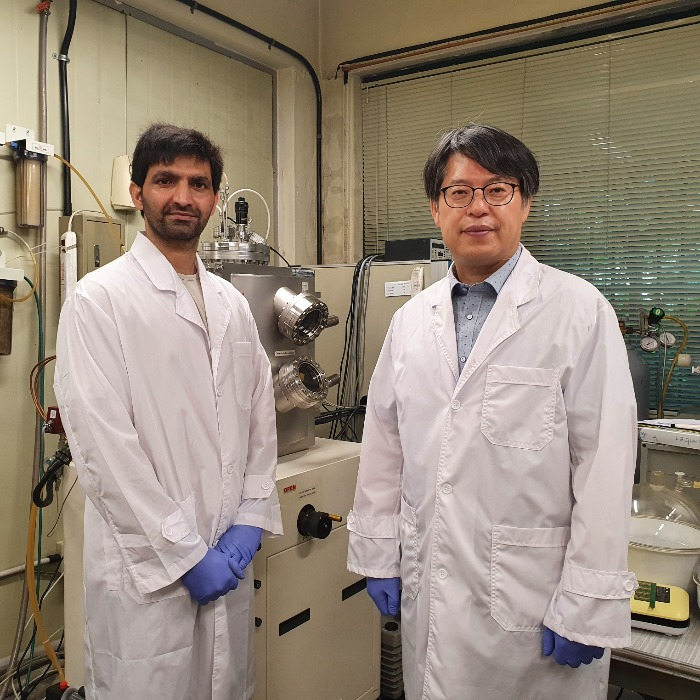Research & Development
Sejong Univ. unveils upgraded biosensor-related technology
The latest bipolar transistor opens the way for developing state-of-the-art biosensors
By Aug 04, 2022 (Gmt+09:00)
2
Min read
Most Read
LG Chem to sell water filter business to Glenwood PE for $692 million


Kyobo Life poised to buy Japan’s SBI Group-owned savings bank


KT&G eyes overseas M&A after rejecting activist fund's offer


StockX in merger talks with Naver’s online reseller Kream


Mirae Asset to be named Korea Post’s core real estate fund operator



South Korea’s Sejong University has developed a technology to sharply reduce the detection time of biomolecules produced by cells and living organisms, which is expected to facilitate the development of biosensors, the university said on Thursday.
Its physics and astronomy department recently unveiled an advanced model of the biopolar junction transistor (BJT), dubbed MoTe2/GeSe/MoTe2, using two-dimensional (2D) materials.
The latest BJT has improved its stability and sensitivity, thus significantly reducing the time for biosensors to detect the COVID-19 protein and other types of proteins.
In the department's laboratory experiment, the device responded quickly to biomolecules with the concentration of 5pM, detecting the latter, called streptavidin, within just 10 seconds.
By comparison, a conventional BJT takes more than 80 minutes to detect biomolecules with a concentration below 10pM. The abbreviation pM stands for particulate matter and measures the concentration of particle size distribution.
“This is meaningful in that this device opened the way for developing state-of-the-art electronic devices such as biosensors that detect DNA proteins, including COVIV-19's,” the university said in the statement.
COVID-19 proteins trigger strokes and heart attacks.
The research was recently published in Advanced Functional Materials, a renowned peer-reviewed scientific journal.
BJTs are the basic building blocks of integrated circuits and control switching applications and logic operations.
"Stability and sensitivity were the hurdles to employing a 2D materials-based electronic device to biosensors,” Dr. Eom Jonghwa, a professor of physics and astronomy at Sejong University, said in a statement.
“I’m very proud of this device solving the two problems simultaneously.”
Highly sensitive and rapid detection of biomolecules is essential for biosensors used in clinical, military and environmental applications.
The stacking of atomically thin 2D semiconductor materials enhances the flow density of electrons and holes within a BJT device.
The thickness of a BJT affects its performance, with its performance decreasing substantially the thicker it is.
Dr. Ghulam Dastgeer, also of Sejong University, is the lead author of the research, jointly conducted by Professor Eom Jonghwa and his lab researchers.
Write to Yeonhee Kim at yhkim@hankyung.com
Jennifer Nicholson-Breen edited this article
More to Read
-
 Business & PoliticsTrump Jr. meets Korean business chiefs in back-to-back sessions
Business & PoliticsTrump Jr. meets Korean business chiefs in back-to-back sessionsApr 30, 2025 (Gmt+09:00)
-
 Korean chipmakersSamsung in talks to supply customized HBM4 to Nvidia, Broadcom, Google
Korean chipmakersSamsung in talks to supply customized HBM4 to Nvidia, Broadcom, GoogleApr 30, 2025 (Gmt+09:00)
-
 EnergyLS Cable breaks ground on $681 mn underwater cable plant in Chesapeake
EnergyLS Cable breaks ground on $681 mn underwater cable plant in ChesapeakeApr 29, 2025 (Gmt+09:00)
-
 Business & PoliticsUS tariffs add risk premium to dollar assets: Maurice Obstfeld
Business & PoliticsUS tariffs add risk premium to dollar assets: Maurice ObstfeldApr 29, 2025 (Gmt+09:00)
-

Comment 0
LOG IN


